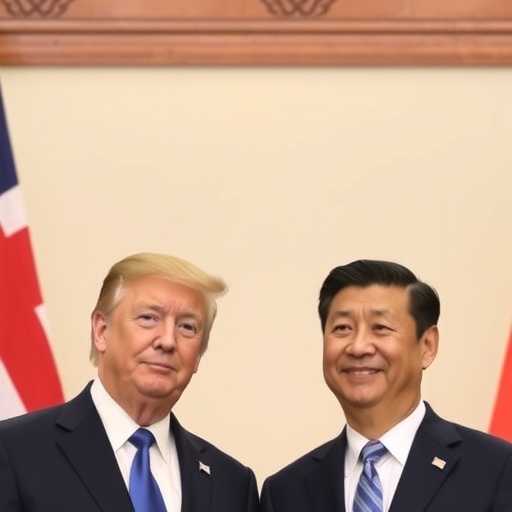US-China Trade Tensions Ease: Trump Prepares for Pivotal Summit with Xi Jinping Amid Tariff Truce
In a surprising turn of events that has Wall Street buzzing and global markets breathing a sigh of relief, US-China trade relations are showing signs of thaw just days before President Trump is set to meet with Chinese President Xi Jinping at a highly anticipated summit. After months of escalating tariffs and a chaotic US government shutdown that disrupted negotiations, both sides have quietly rolled back select duties on key imports, hinting at a potential de-escalation in the long-standing economic standoff between the world’s two largest economies.
This development comes at a critical juncture, with the summit scheduled for next week in Buenos Aires, Argentina, on the sidelines of the G20 gathering. Sources close to the White House indicate that the partial truce is a deliberate goodwill gesture from both Trump and Xi Jinping, aimed at creating a more conducive atmosphere for dialogue. The move has already boosted US stock indices, with the Dow Jones Industrial Average climbing 2.3% in early trading today, reflecting investor optimism about reduced uncertainty in China-US trade.
The easing of tensions marks a stark contrast to the aggressive rhetoric that defined the past year, where Trump‘s administration imposed tariffs on over $250 billion worth of Chinese goods, prompting retaliatory measures from Beijing that hit American farmers and manufacturers hard. As preparations for the Trump–Xi Jinping summit intensify, analysts are watching closely to see if this momentum can lead to a broader agreement, potentially averting a full-blown trade war that economists warn could shave 0.5% off global GDP growth in 2019.
Tariff Rollbacks Herald New Chapter in US-China Trade Dynamics
The first concrete signs of relief emerged late last week when the US trade representative’s office announced the suspension of tariffs on $16 billion in Chinese electronics and machinery imports. This decision, effective immediately, reverses duties that had been in place since September 2018 and affects products ranging from semiconductors to industrial robots—sectors vital to both nations’ tech ambitions. In response, China followed suit by lifting its own tariffs on $10 billion of US agricultural products, including soybeans and pork, which had been targeted in retaliation to Trump‘s initial salvos.
According to data from the US Census Bureau, US exports to China plummeted by 13% in the first half of 2019 due to these barriers, costing American exporters an estimated $27 billion. The rollback is expected to inject much-needed liquidity into these markets; for instance, Midwest farmers, who supply 60% of US soybeans to China, could see prices rebound by up to 15%, per USDA projections. “This is a pragmatic step that acknowledges the mutual pain of the trade dispute,” said Robert Lighthizer, the US trade representative, in a statement released yesterday. “It sets the stage for productive discussions at the upcoming summit with President Xi Jinping.”
From Beijing’s perspective, the concessions underscore China‘s willingness to engage without appearing weak. State media outlets like Xinhua have framed the moves as evidence of Xi Jinping‘s leadership in fostering “win-win cooperation,” a phrase that has become a staple in Chinese diplomatic lexicon. Yet, not all tariffs are off the table; the 25% duties on $200 billion of goods remain, serving as leverage in ongoing talks. This selective easing suggests a calculated strategy by both Trump and Xi Jinping to build trust incrementally ahead of their face-to-face meeting.
Government Shutdown’s Ripple Effects on Bilateral Negotiations
The US government shutdown from December 2018 to January 2019, the longest in history at 35 days, cast a long shadow over US-China trade talks, halting key negotiations and furloughing hundreds of trade specialists at agencies like the Department of Commerce. This domestic turmoil, triggered by disputes over border wall funding, inadvertently amplified the chaos in international relations, delaying a planned round of talks in Washington and forcing diplomats to work remotely amid uncertainty.
During the shutdown, US negotiators missed critical deadlines for reviewing China‘s compliance with intellectual property protections—a core US demand in the trade dispute. A report by the Peterson Institute for International Economics estimates that the impasse cost the US economy an additional $1.2 billion in lost trade opportunities with China, as potential deals on market access for American firms languished. “The shutdown was a self-inflicted wound that emboldened China to dig in its heels,” noted economist Gary Hufbauer, a senior fellow at the institute. “But now, with stability restored, Trump has a window to refocus on the summit with Xi Jinping.”
Chinese officials, speaking anonymously to Reuters, expressed frustration over the US’s internal distractions, viewing them as a sign of political instability under Trump. However, the partial reopening of government operations in late January allowed talks to resume virtually, culminating in the tariff suspensions announced this week. This episode highlights the interconnectedness of domestic US politics and global trade strategy, with the shutdown ultimately serving as a catalyst for both sides to prioritize de-escalation.
To illustrate the broader impacts, consider the following key statistics from the period:
- US manufacturing output fell 1.3% in Q1 2019, partly due to trade uncertainties exacerbated by the shutdown.
- China‘s imports of US goods dropped 20% year-over-year, straining bilateral ties.
- Over 800,000 federal workers were affected, including those in trade enforcement roles.
These figures underscore why the current easing is seen as a vital reset, paving the way for substantive progress at the Trump–Xi Jinping summit.
Stakes High for Trump-Xi Summit: Key Agenda Items Revealed
As Trump and Xi Jinping gear up for their summit, the agenda is laser-focused on resolving flashpoints that have defined the US-China trade rift. Topping the list is intellectual property theft, with the US accusing China of costing American firms up to $600 billion annually through forced technology transfers and cyber espionage. Washington is pushing for enforceable commitments from Beijing, including stricter penalties for IP violations and greater market access for US tech giants like Apple and Qualcomm.
Another critical area is agricultural trade, where China‘s retaliatory tariffs devastated US exports. The summit could yield promises from Xi Jinping to increase purchases of American soybeans, corn, and energy products, potentially stabilizing prices for US farmers who have turned to government subsidies totaling $12 billion since the dispute began. “We’re looking for concrete actions, not just words,” Trump tweeted earlier this week, emphasizing his administration’s “America First” approach.
Energy and currency manipulation round out the priorities. The US seeks assurances that China will refrain from devaluing the yuan to gain export advantages, a charge Beijing denies. On the energy front, deals for US liquefied natural gas (LNG) exports to China could be accelerated, with projections from the Energy Information Administration suggesting a 25% uptick in shipments post-summit. White House advisors have leaked that Trump plans to leverage personal rapport with Xi Jinping, built during their 2017 Mar-a-Lago meeting, to broker a 90-day truce on further tariffs if progress is made.
International observers, including EU trade commissioner Cecilia Malmström, have voiced support for the summit, warning that failure could trigger a domino effect on global supply chains. “The world can’t afford a prolonged US-China trade war,” she said in a recent interview.
Market Reactions and Expert Predictions on Post-Summit Trade Landscape
Financial markets have responded enthusiastically to the thawing US-China trade tensions, with Asian indices like the Shanghai Composite rising 1.8% and European bourses following suit. In the US, sectors poised to benefit—such as technology and agriculture—saw sharp gains; shares of Boeing, a major exporter to China, surged 4.2% on news of the tariff relief. Economists at Goldman Sachs now forecast a 0.3% lift to US GDP growth in the second half of 2019 if the Trump–Xi Jinping summit yields even modest agreements.
Experts are divided on the long-term outlook. Optimists like former US ambassador to China Max Baucus predict a “phase one” deal by year’s end, covering 70% of disputed tariffs. “Trump‘s deal-making style could surprise us,” Baucus told CNBC. Pessimists, however, point to deep-seated issues like China‘s state subsidies for industries such as steel and solar, which the US views as unfair competition. “The summit might buy time, but structural reforms in China are non-negotiable,” argued Wendy Cutler, a trade negotiation veteran.
Broader implications extend to global alliances. A successful summit could ease pressures on US allies like Japan and the EU, who have faced collateral damage from diverted China imports. Conversely, escalation might accelerate “decoupling” trends, with companies like Foxconn exploring shifts in manufacturing away from China. Surveys by McKinsey indicate that 40% of US firms are already diversifying supply chains, a trend that could intensify without a trade breakthrough.
Looking ahead, the Trump–Xi Jinping summit represents a pivotal moment that could redefine US-China economic interdependence. If negotiations falter, fresh tariffs loom, potentially reigniting volatility. Yet, with both leaders invested in projecting strength and stability, the stage is set for a diplomatic push that might just bridge the divide, fostering a more balanced trade relationship for the decade to come. Stakeholders from Washington to Beijing are holding their breath, knowing the outcomes will ripple across global markets and geopolitics.








